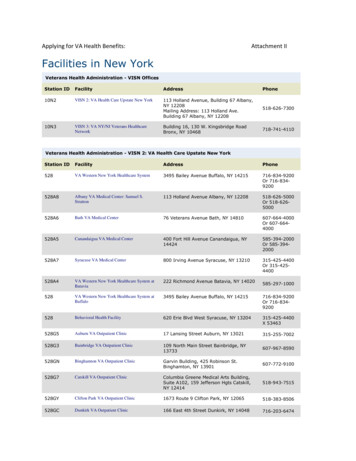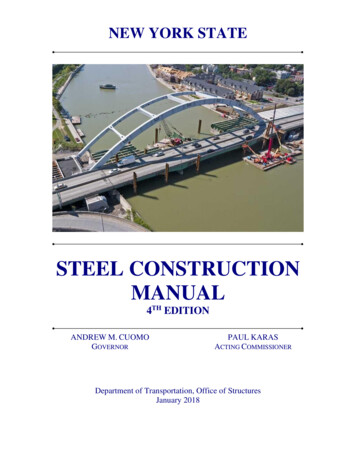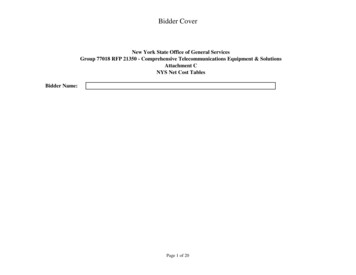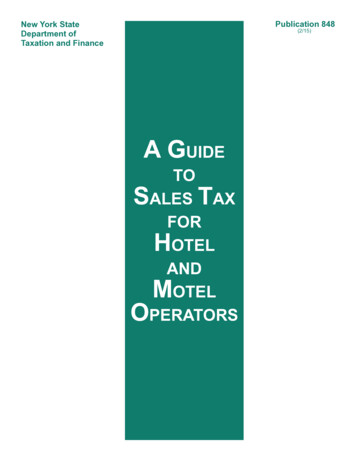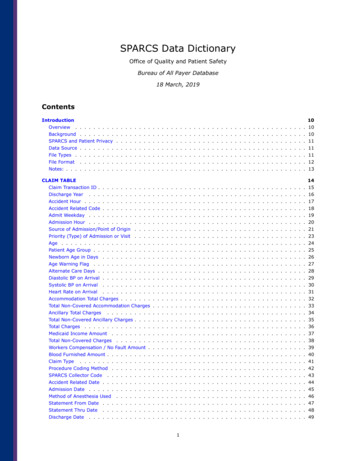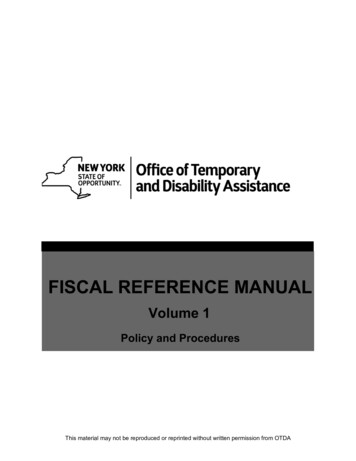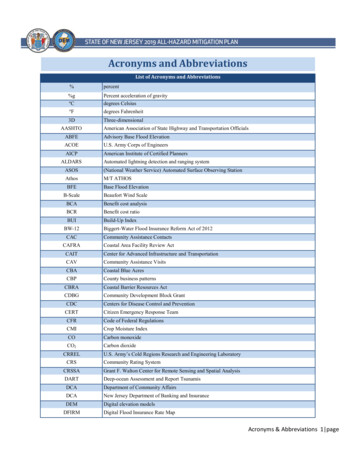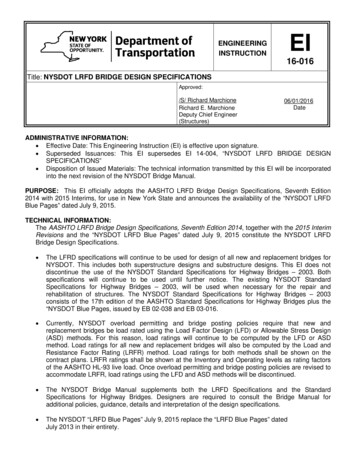
Transcription
EIENGINEERINGINSTRUCTION16-016Title: NYSDOT LRFD BRIDGE DESIGN SPECIFICATIONSApproved:/S/ Richard MarchioneRichard E. MarchioneDeputy Chief Engineer(Structures)06/01/2016DateADMINISTRATIVE INFORMATION: Effective Date: This Engineering Instruction (EI) is effective upon signature. Superseded Issuances: This EI supersedes EI 14-004, “NYSDOT LRFD BRIDGE DESIGNSPECIFICATIONS” Disposition of Issued Materials: The technical information transmitted by this EI will be incorporatedinto the next revision of the NYSDOT Bridge Manual.PURPOSE: This EI officially adopts the AASHTO LRFD Bridge Design Specifications, Seventh Edition2014 with 2015 Interims, for use in New York State and announces the availability of the “NYSDOT LRFDBlue Pages” dated July 9, 2015.TECHNICAL INFORMATION:The AASHTO LRFD Bridge Design Specifications, Seventh Edition 2014, together with the 2015 InterimRevisions and the “NYSDOT LRFD Blue Pages” dated July 9, 2015 constitute the NYSDOT LRFDBridge Design Specifications. The LFRD specifications will continue to be used for design of all new and replacement bridges forNYSDOT. This includes both superstructure designs and substructure designs. This EI does notdiscontinue the use of the NYSDOT Standard Specifications for Highway Bridges – 2003. Bothspecifications will continue to be used until further notice. The existing NYSDOT StandardSpecifications for Highway Bridges – 2003, will be used when necessary for the repair andrehabilitation of structures. The NYSDOT Standard Specifications for Highway Bridges – 2003consists of the 17th edition of the AASHTO Standard Specifications for Highway Bridges plus the“NYSDOT Blue Pages, issued by EB 02-038 and EB 03-016. Currently, NYSDOT overload permitting and bridge posting policies require that new andreplacement bridges be load rated using the Load Factor Design (LFD) or Allowable Stress Design(ASD) methods. For this reason, load ratings will continue to be computed by the LFD or ASDmethod. Load ratings for all new and replacement bridges will also be computed by the Load andResistance Factor Rating (LRFR) method. Load ratings for both methods shall be shown on thecontract plans. LRFR ratings shall be shown at the Inventory and Operating levels as rating factorsof the AASHTO HL-93 live load. Once overload permitting and bridge posting policies are revised toaccommodate LRFR, load ratings using the LFD and ASD methods will be discontinued. The NYSDOT Bridge Manual supplements both the LRFD Specifications and the StandardSpecifications for Highway Bridges. Designers are required to consult the Bridge Manual foradditional policies, guidance, details and interpretation of the design specifications. The NYSDOT “LRFD Blue Pages” July 9, 2015 replace the “LRFD Blue Pages” datedJuly 2013 in their entirety.
EI 16-016 Page 2 of 2IMPLEMENTATION:This Engineering Instruction (EI) is effective immediately for all structural design projects in New YorkState unless immediate implementation will result in undue delay to projects currently under design asdetermined by the Regional Director and the Deputy Chief Engineer (Structures).TRANSMITTED MATERIALS:The NYSDOT “LRFD Blue Pages” dated July 9, 2015 can be found at the following web ng/structures/manualsCONTACT: Direct questions regarding this EI to Mathew Royce of the Office of Structures at (518) 4857256, or by e-mail to mathew.royce@dot.ny.gov
July 2015NEW YORK STATE DEPARTMENT OF TRANSPORTATIONLRFD BLUE PAGESTABLE OF .1.2.6a3.6.1.63.6.5.13.7.5C3.7.53.9.2.1 (New)C3.9.2.2 (New)3.9.3 (New)C3.9.3 (New)3.10.1C3.10.2.13.10.2.2 (New)3.10.53.10.7.1 (New)3.10.11C3.10.113.10.11.2Appendix A3.10 (New)3.12.23.12.2.13.12.2.2Article3.14.1 (New)3.14.2 (New)3.14.3 (New)3.14.4 4.2 (New)4.7.4.3.14.7.4.3.4b 13.2.4.1b (New)6.13.2.4.1c (New)6.13.2.4.1d (New)6.13.2.6.16.13.2.86.13.3.16.13.6.1.1 4.111.10.10.1 .2
July 2015
July 2015
July 20151.1SCOPE OF THE SPECIFICATIONDelete the sixth paragraph of Article 1.1 and replace it withthe following:Seismic design shall be in accordance with the provisionsin these specifications. Seismic design in accordance withthe provisions given in the AASHTO Guide Specificationsfor LRFD Seismic Bridge Design can be used with theapproval of Deputy Chief Engineer (Structures).
July 2015
July 20151.3DESIGN PHILOSOPHY1.3.5Operational ImportanceDelete the third paragraph and replace it with thefollowing:For the strength limit state:η I 1.05 for critical bridges* 1.00 for essential and other bridgesFor all other limit states:η I 1.00*For definition of critical bridges, see Blue Page 3.10.5.
July 2015
July 20153.4LOAD FACTORS AND COMBINATIONS3.4.1Load Factors and Load CombinationsDelete the sixth bullet of the second paragraph and replaceit with the following: EXTREME EVENT I - Load combination includingearthquake. The load factor for live load γEQ, shall be 0.5for bridges with Average Daily Truck Traffic (ADTT)greater than 5000 and 0.00 for all other bridges.
July 2015
July 20153.4LOAD FACTORS AND COMBINATIONS3.4.1Load Factors and Load CombinationsAdd to Table 3.4.1-2 the following:For reinforcement design of an integral abutment, apassive lateral earth pressure load factor of 1.5 shall beused.
July 20153.4LOAD FACTORS AND COMBINATIONS3.4.1Load Factors and Load CombinationsDelete the second to last paragraph of Article 3.4.1.
July 2015
July 20153.6LIVE LOADS3.6.1Gravity Loads: LL and PL3.6.1.2Design Vehicular Live Load3.6.1.2.1GeneralAdd to the first paragraph of Article 3.6.1.2.1 thefollowing:NY State owned bridges (including state owned bridgescarrying parkways), all bridges on the National HighwaySystem and all bridges on the state touring routes shallalso be designed for the NYSDOT Design Permit Vehicle inaccordance with Article 3.6.1.2.4a, unless otherwiseapproved by Deputy Chief Engineer (Structures).
July 2015
July 20153.6LIVE LOADS3.6.1Gravity Loads: LL and PL3.6.1.2Design Vehicular Live LoadAdd a new Article 3.6.1.2.4a:3.6.1.2.4a NYSDOT Design Permit VehicleThe NYSDOT Design Permit Vehicle is a design vehicularload to be applied to the “Strength II” limit state. For prestressed concrete bridges, the NYSDOT Design PermitVehicle shall also be used for the “Service III” limit stateas a design load case in addition to the AASHTO HL93 liveload (see Article 5.9.4.2.2 for Service III resistance limits).All ratable elements (such as beams, girders, steel capbeams and steel columns) of new and replacement bridgesshall satisfy these limit states using NYSDOT Design PermitVehicle.The design permit vehicle loading shall be used for all stateowned bridges (including state owned bridges carryingparkways), all bridges on the National Highway Systemand all bridges on the state touring routes unlessotherwise approved by Deputy Chief Engineer (Structures).Other bridges may be designed for NYSDOT Design PermitVehicle at the option of the owner. Bridge rehabilitationdesigns where the primary structural members are beingretained may also use the design permit vehicle.The weights and spacing of axles for NYSDOT designpermit vehicle shall be as specified in Figure 3.6.1.2.4a-1.The transverse spacing of wheels shall be taken as 6 feet.The dynamic load allowance shall be applied as specified inArticle 3.6.2.
July 20153.6.1.2.4a (continued)When the bridge is analyzed using the approximate loaddistribution factors as specified in Article 4.6.2, thedistribution factor for one traffic lane shall be used. Themultiple presence factor for one lane loaded (see Article3.6.1.1.2) shall be included, except for exterior girders ofmulti-girder bridges where NYSDOT Design Permit Vehicleload distribution factor is calculated using the lever rule asspecified in Article 4.6.2. The Engineer shall use thehigher of either the distribution factor calculated using thelever rule without multiple presence factor or thedistribution factor calculated using the rigid body methodwith multiple presence factor. The provisions of Article4.6.2.2.5 may be used as an alternate method to accountfor multiple presences when using the approximate loaddistribution factors.When the bridge is not analyzed using the approximateload distribution factors as specified in Article 4.6.2,NYSDOT Design Permit Vehicle shall be applied to a singledesign lane only. The multiple presence factor for one laneloaded (see Article 3.6.1.1.2) shall be included. If thereare multiple lanes on the bridge, the other lanes shall beassumed to be occupied by AASHTO HL-93 live load asspecified in the Commentary of Article 3.4.1 underStrength II. The appropriate multiple presence factor (seeArticle 3.6.1.1.2) shall be included.Figure 3.6.1.2.4a-1 Characteristics of the NYSDOT DesignPermit Vehicle
July 20153.6LIVE LOADS3.6.1Gravity Loads: LL and PL3.6.1.2Design Vehicular Live Load3.6.1.2.6Distribution of Wheel Loads through Earth Fills3.6.1.2.6a GeneralIn the first sentence of the second and third paragraphs,add ‘box or,’ just before the words ‘flat top three-sided’.
July 2015
July 2015
July 20153.6LIVE LOADS3.6.1Gravity Loads: LL and PL3.6.1.6Pedestrian LoadsDelete the first paragraph of Article 3.6.1.6 and replace itwith the following:Pedestrian load shall be neglected if the sidewalk width isless than or equal to 10.0 ft, and no physical barrier existsbetween vehicular traffic and sidewalk.If the pedestrian load is neglected, then the HL 93 live loadshall be assumed to mount the sidewalk, and shall beapplied at 1 ft. from the face of the bridge railing for thedesign of the overhang, and 2 ft. from the face of thebridge railing for the design of all other components. TheNYSDOT Design Permit Vehicle shall be applied 2 ft. fromthe edge of curb for the design of all components.When the sidewalk is greater than 10.0 ft, or when aphysical barrier exists between vehicular traffic and thesidewalk, a pedestrian load of 0.075 ksf shall be applied toall sidewalk areas, and shall be considered simultaneouslywith the vehicular design live load applied 2 ft. from theedge of curb. The NYSDOT Design Permit Vehicle shall beapplied 2 ft. from the edge of curb for the design of allcomponents.All bridges shall be checked for the live load case wherethe sidewalk is removed in the future.The Load Rating shall be for the case where the HL 93 liveload is applied 2 ft. from the edge of curb and nopedestrian load on the sidewalk.
July 20153.6LIVE LOADS3.6.5Vehicular Collision Force: CT3.6.5.1Protection of StructuresAdd the following to the end of second paragraph.For hammerhead and multi-column piers, the preferreddesign choice is to redirect or absorb the collision loadwherever it is feasible.Add the following paragraph to the end of Article 3.6.5.1:Structures crossing railroad tracks with crash wallsdesigned in accordance with the American RailwayEngineering and maintenance of Way Association (AREMA)specifications are exempt from the provisions of Article3.6.5.1. Abutments that are at least 2’-6” thick and atleast 12 feet long are also exempt from these provisions.
July 2015
July 20153.7WATER LOADS: WA3.7.5Change in Foundations Due to Limit State for ScourAdd the following paragraphs to the end of this article.The following changes in foundation condition shall beconsidered for the service, strength, and extreme eventlimit states for typical foundations supported on piles anddrilled shafts.For piles and drilled shafts at all scour depths, thesurrounding soil above the scour elevation provides nolateral support.For abutments having battered piles, the reduced lateralsoil resistance and increased displacement caused by thescour is counteracted by the battered piles, negating theneed for a scour case lateral analysis. This applies tointegral abutments with vertical piles as well, except thelateral stability comes from the abutments fixed connectionwith the superstructure rather than the battered piles. Thestructural resistance of the piles for the scour case shall bedetermined based on applied vertical loads without lateralloads, using an unbraced length set equal to the scourdepth.For piers, the structural resistance of the pile or drilledshaft for the scour case shall be determined based onapplied vertical and horizontal loads, using an unbracedlength set equal to the scour depth.If the calculated displacement of the pile or drilled shaft,based on group analysis, under the applied lateral loads isless than 4 inches, no further checks are necessary.If the pile or drilled shaft displacement is greater than 4inches or when the displacement is unknown, thesuperstructure to substructure connection shall bedesigned for the applicable limit state.In all cases, the geotechnical resistance of the piles anddrilled shafts shall account for scour as stated in articles10.7.3.6 or 10.8.3.3, as applicable.
July 20153.7WATER LOADS: WA3.7.5Change in Foundations Due to Limit State for ScourC3.7.5Delete the Commentary to Article 3.7.5 and replace it withthe following:Designing for large scour depths is impractical for pilefoundations at abutments given the conservatism of thecurrent state of practice. Based on NYSDOT’s experienceand design methodology, the excess resistance of theabutment battered piles sufficiently counter balances thedecrease in lateral resistance and the theoretical increasein displacement that the design models predict for a scourevent. Therefore, because of the inherent conservatism inNYSDOT’s current state of practice combined withNYSDOT’s inspection program, a rigorous late
01.06.2016 · consists of the 17th edition of the AASHTO Standard Specifications for Highway Bridges plus the “NYSDOT Blue Pages, issued by EB 02-038 and EB 03-016. Currently, NYSDOT overload permitting and bridge posting policies require that new and replacement bridges be load rated using the Load Factor Design (LFD) or Allowable Stress Design (ASD) methods. For this reason, load ratings File Size: 1MBPage Count: 203
